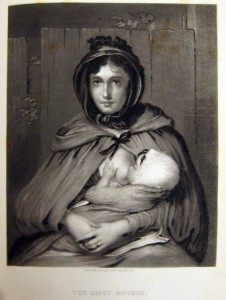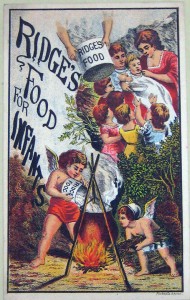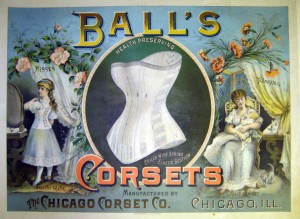When I first told people I’d decided to nurse my twins I was asked jokingly, “So you’re going to hire a wet nurse?” followed by “too bad they’re not around anymore.”
Of course they are, I thought – just ask Salma Hayek.
 For awhile I didn’t think about nursing history, until I recently saw in the Graphic Arts workroom an engraving entitled “The gipsy mother” which was based on a painting by Sir David Wilkie. The image, displayed here, features a mother unashamedly breastfeeding her child while facing the viewer. Published in 1840s annuals such as the Gallery of mezzotints, it is yet another example of the rich images in the gift books collection. For more about our current project to get these images cataloged and searchable via the AAS online catalog with reference size images, see our earlier blog post on Prints in the Parlor. While the scene is visually stunning, revealing, and personal it begs the question, when did we become so sensitive about something so natural? Especially if such scenes of nursing were commonplace enough to be reproduced repeatedly, annually even?
For awhile I didn’t think about nursing history, until I recently saw in the Graphic Arts workroom an engraving entitled “The gipsy mother” which was based on a painting by Sir David Wilkie. The image, displayed here, features a mother unashamedly breastfeeding her child while facing the viewer. Published in 1840s annuals such as the Gallery of mezzotints, it is yet another example of the rich images in the gift books collection. For more about our current project to get these images cataloged and searchable via the AAS online catalog with reference size images, see our earlier blog post on Prints in the Parlor. While the scene is visually stunning, revealing, and personal it begs the question, when did we become so sensitive about something so natural? Especially if such scenes of nursing were commonplace enough to be reproduced repeatedly, annually even?
Being a good researcher, I dutifully looked to the archive for answers. In addition to maternal and infant care manuals (as well as the exceedingly insightful letters in the Grant Burr Family Papers on the subject of breast care) there were two items I thought exceptionally blog-worthy –
The first evoked a conversation I had with a lactation consultant who told me women today are a full three generations away from nursing. So I figured if I looked back 100 years or so (in a time when mercury was medicinal), I would find the roots of the practice of nursing being replaced by the bottle. Surely, early advertising cards will enlighten us?
 Not surprisingly, trade cards for infant formulas were informative. The “Ridge’s Food for Infants” trade card as seen here claims to not only be affordable but a necessity for babies (to boot, its flourished with rock-solid endorsements).
Not surprisingly, trade cards for infant formulas were informative. The “Ridge’s Food for Infants” trade card as seen here claims to not only be affordable but a necessity for babies (to boot, its flourished with rock-solid endorsements).
The card, produced in Boston by Woolrich & Co. dates to between 1875 and 1900. The reverse of the card draws would-be consumer’s attention to the fact that “multitudes of infants are slowly starving at a period of infancy when development and growth are remarkably active” (cue the anticipated mom-freak-out moment) because of the mother’s inability to produce enough milk. This, of course, compromises the health in both mom and baby. The front of the card features a maternal vignette scene of a mother surrounded by children feeding her young infant Ridge’s with a spoon and bowl. In the foreground, two winged figures prepare the formula in an outdoor (aka natural) looking scene. What is striking about this, of course, is that the making of processed formula is made to look more “natural” than that of a mother breastfeeding her child.
In contrast to infant formula advertising, for those mothers who wanted to avoid a wardrobe malfunction while nursing, there were “Ball’s Corsets” by the Chicago Corset Company. The  chromolithographed print shown here was published about 1880 and promises “solid comfort” for those breastfeeding. Two women are in the scene (flanking a large corset which exposes front, interior and side of the piece) – the woman to the left is a “Miss” admiring herself at her dressing table and stating “I breathe to live”. The woman to the right is a mother facing her viewer and watching her nursing child. The infant is successfully breastfeeding due to the ease and support of the corset (evidenced by the mother’s maternal affection and sense of security on her face).
chromolithographed print shown here was published about 1880 and promises “solid comfort” for those breastfeeding. Two women are in the scene (flanking a large corset which exposes front, interior and side of the piece) – the woman to the left is a “Miss” admiring herself at her dressing table and stating “I breathe to live”. The woman to the right is a mother facing her viewer and watching her nursing child. The infant is successfully breastfeeding due to the ease and support of the corset (evidenced by the mother’s maternal affection and sense of security on her face).
These items in no way survey all of the visual representations on the subject of nursing present in AAS collections, but they do demonstrate the response to breastfeeding as one varied in the nineteenth-century as it is today. Additionally, they reveal how something so personal could be artistically conveyed.
